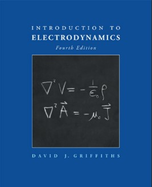Solution Found!
Derive Eq. 6.3. [Here’s one way to do it: Assume the
Chapter 6, Problem 4P(choose chapter or problem)
Problem 4P
Derive Eq. 6.3. [Here’s one way to do it: Assume the dipole is an infinitesimal square, of side _ (if it’s not, chop it up into squares, and apply the argument to each one). Choose axes as shown in Fig. 6.8, and calculate along each of the four sides. Expand B in a Taylor series—on the right side, for instance,
For a more sophisticated method, see Prob. 6.22.]
Reference prob 6.22
In Prob. 6.4, you calculated the force on a dipole by “brute force.” Here’s a more elegant approach. First write B(r) as a Taylor expansion about the center of the loop:
Derive Eq. 6.3. [Here’s one way to do it: Assume the dipole is an infinitesimal square, of side _ (if it’s not, chop it up into squares, and apply the argument to each one). Choose axes as shown in Fig. 6.8, and calculate along each of the four sides. Expand B in a Taylor series—on the right side, for instance,
For a more sophisticated method, see Prob. 6.22.]
Reference prob 6.22
In Prob. 6.4, you calculated the force on a dipole by “brute force.” Here’s a more elegant approach. First write B(r) as a Taylor expansion about the center of the loop:
Questions & Answers
QUESTION:
Problem 4P
Derive Eq. 6.3. [Here’s one way to do it: Assume the dipole is an infinitesimal square, of side _ (if it’s not, chop it up into squares, and apply the argument to each one). Choose axes as shown in Fig. 6.8, and calculate along each of the four sides. Expand B in a Taylor series—on the right side, for instance,
For a more sophisticated method, see Prob. 6.22.]
Reference prob 6.22
In Prob. 6.4, you calculated the force on a dipole by “brute force.” Here’s a more elegant approach. First write B(r) as a Taylor expansion about the center of the loop:
Derive Eq. 6.3. [Here’s one way to do it: Assume the dipole is an infinitesimal square, of side _ (if it’s not, chop it up into squares, and apply the argument to each one). Choose axes as shown in Fig. 6.8, and calculate along each of the four sides. Expand B in a Taylor series—on the right side, for instance,
For a more sophisticated method, see Prob. 6.22.]
Reference prob 6.22
In Prob. 6.4, you calculated the force on a dipole by “brute force.” Here’s a more elegant approach. First write B(r) as a Taylor expansion about the center of the loop:
ANSWER:
Solution
Step 1 of 5
In this problem, we have to calculate in each side and expand the given B in a Taylor series on the right side of the given figure. The free body diagram of this problem is given below.
